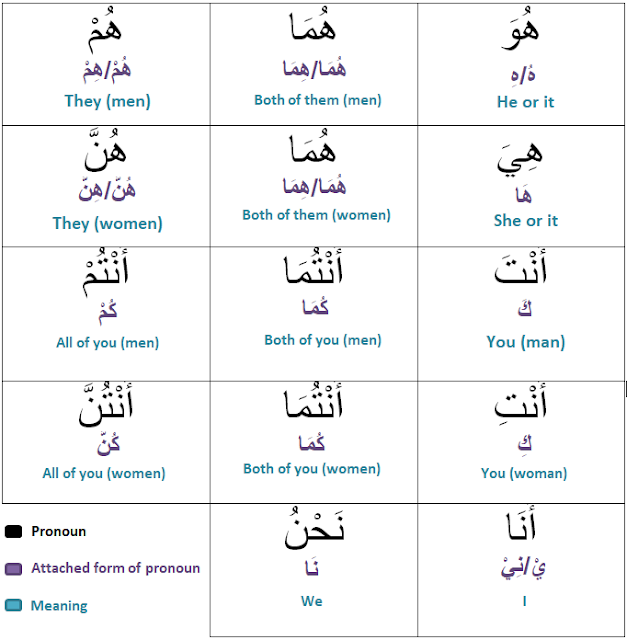Isms: Lesson 1
Before we go to the next topic, we should know that
generally there are 3 kinds of words in Arabic. They are:
1.
Fi’l (verbs – eg: eat, go, begin)
2.
Ism (nouns – eg: cat, house, rat)
3.
Harf (words that make no sense unless another word is
added to it – eg: it, is, the, a)
So far we learned something about Fi’ls (verbs). Fi’ls will
be detailed in upcoming lessons In Sha Allah but for now we are going to start
with Isms (nouns).
The first thing we should know about isms, is that each ism
has 4 properties. These are like the ‘4 wheels’ of an ism. The 4 properties
are:
1.
Status
2.
Number
3.
Gender
4.
Type
We will be learning about each property separately so that we
are clear about all 4 properties. So today, we will be learning about the first
property which is, ‘status’.
Whenever we have an ism (noun) in Arabic, it will fall into
one of 3 statuses. It would either be رَفَع,
نَصب or جَر.
Explained below is what each of these statuses mean and how to identify those
statuses.
رَفَع – This is
the name given to the doer. This the one who does something in a sentence.
Eg 1: I ate an apple.
‘I’ is the رَفَع
(doer) in the sentence because ‘I’ is doing the act of eating.
Eg 2: Yaseen plays football.
‘Yaseen’ is the رَفَع
(doer) in this sentence because ‘Yaseen’ is doing the act of playing.
* Rafa’ will usually have a dhamma (ubufili) on the last
letter.
نَصب – This is
the name given to the detail given in a sentence. We identify the نَصب
by asking questions.
Eg 1: I ate an apple.
For this sentence, a question can be made like: What did I eat?
The answer would be ‘apple’. So ‘apple’ is the نَصب
(detail)
Eg 2: Yaseen plays football.
For this sentence, a question can be made like: What did Yaseen play? The answer would be ‘football’. So ‘football’ is the نَصب
(detail)
* Nasb will usually have a fathhah (abafili) in the last
letter.
جَر – Jarr is
any word that has a kasra (ibifili) on the last letter. We will be learning in
detail about Jarr in a later lesson In Sha Allah.
Mental Exercise:
Identify the Rafa’ (doer) and Nasb (detail) in the sentences
below.
1.
The kids played scrabble
2.
They broke the lamp
3.
The mother of Ahmed yelled at him.
4.
The boys went to the park in the summer.
5.
The grown-ups bought the lemonade.
6.
The teenagers memorized the Quran.
7.
An alarm clock rang loudly.
8.
The class of 2014 graduated.
************************************************************
ދެން އޮތް ފިލާވަޅަށް ދިޔުމުގެ ކުރިން ދެނެގަންނަންޖެހޭ
އެއްކަމެއް އެބައޮތެވެ. އެއީ ޢަރަބި ބަހުގައި ޢާއްމުގޮތެއްގައި ފެނިގެން ދާނީ 3
ވައްތަރެއްގެ ބަސްކަމެވެ. އެއީ:
ފިޢްލް (ކަން – މިސާލު: ކެއުން، ދިޔުން، ފެށުން)
އިސްމް (ނަން – މިސާލު: ބުޅާ، ގެ، މީދާ)
ޙަރްފް (މިއީ އެހެން ބަހަކާއި ނުގުޅޭނެ ނަމަ އެއްވެސް
މާނައެއް ނުނެގޭނެ ބަސްތަކެވެ. – މިސާލު: އަދި، އެއީ، ދެން)
މިހާތަނަށް އައިއިރު އަހަރުމެން ބަލާފައިވާނީ ހަމައެކަނި
ފިޢްލްތަކަށެވެ. ކުރިއަށް ހުރި ފިލާވަޅުތަކުގެ ފިޢްލްތައް އިތުރަށް ތަފްޞީލުވެގެން
ދާނެއެވެ. (އިން ޝާ ﷲ) މިއަދު އަހަރުމެން ފަށާނީ 'އިސްމް' (ނަން) ގެ ފިލާވަޅެވެ.
އިސްމް އާއި ބެހޭގޮތުން އެންމެ ފުރަތަމަ އެނގެން ޖެހޭ
ކަމަކީ ކޮންމެ އިސްމްއެއްގައި ވެސް 4 ސިފަވާކަމެވެ. މިއީ އިސްމްއެއްގެ '4
ފުރޮޅިއެވެ.' މި 4 ސިފައަކީ:
މަޤާމް
ޖިންސު
ޢަދަދު
ވައްތަރު
މީގެއިން ކޮންމެ ސިފައަކާމެދު އަހަރުމެން ދަސްކުރާނީ
ވަކިންނެވެ. ކޮންމެ ސިފައެއް ރަނގަޅަށް ސާފުވާނެ ފަދައިންނެވެ. އެހެންކަމުން
މިއަދު އަހަރުމެން ބަލާލާނީ އިސްމްއެއްގެ ފުރަތަމަ ސިފަ ކަމަށްވާ 'މަޤާމް' އަށެވެ.
ޢަރަބި ބަހުގައި އިސްމްއެއް ފެންނަ ކޮންމެ ފަހަރަކު އެ
އިސްމް ވާނީ 3 މަޤާމުންކުރެ އެއް މަޤާމަކަށް ނިސްބަތްވާ އިސްމްއަކަށެވެ. އެ 3
މަޤާމަކީ رَفَع، نَصب އަދި جَر އެވެ. މީގެއިން ކޮންމެ މަޤާމެއްގެ މާނައާއި އޭތި ދެނެގަންނާނެ ގޮތް ތިރީގައި
އެ ވަނީ ބުނެދެވިފައެވެ.
رَفَع – މިއީ ޖުމްލައެއްގައި
ކަންކުރާ ފަރާތެވެ.
މިސާލު 1: އަހަރެން އާފަލެއް ކެއީމެވެ.
މި ޖުމްލައިގައި ކަންކުރާ ފަރާތަކީ 'އަހަރެން' އެވެ.
އެހެންކަމުން މި ޖުމްލައިގެ رَفَع އަކީ 'އަހަރެން' އެވެ.
މިސާލު 2: ޔާސީން ފުޓުބޯޅަ ކުޅެއެވެ.
މި ޖުމްލައިގައި ކަންކުރާ ފަރާތަކީ 'ޔާސީން' އެވެ.
އެހެންކަމުން މި ޖުމްލައިގެ رَفَع އަކީ 'ޔާސީން' އެވެ.
* ޢާއްމުގޮތެއްގައި ޢަރަބި ބަހުގައި رَفَع ބަސްތައް ނިމޭނީ އުބުފިލިއަކުންނެވެ.
نَصب – މިއީ ޖުމްލައެއްގައި ކަމެއް ތަފްޞީލުކުރަން ބޭނުން
ކުރެވޭ ބަސްތަކެވެ. ނަޞްބްއަކީ ކޮބައިކަން ޖުމްލައަކުން ހޯދާނީ ސުވާލުތަކެއް
އުފައްދައިގެންނެވެ.
މިސާލު 1: އަހަރެން އާފަލެއް ކެއީމެވެ.
މި ޖުމްލައަށް މި ޒާތުގެ ސުވާލެއް ހެދިދާނެއެވެ. އަހަރެން
ކެއީ ކޯޗެއް ހެއްޔެވެ؟ ކެއީ 'އާފަލެކެވެ.' އެހެންކަމުން ނަޞްބްއަށް ވާނީ
'އާފަލެވެ.'
މިސާލު 2: ޔާސީން ފުޓުބޯޅަ ކުޅެއެވެ.
މި ޖުމްލައަށް މި ޒާތުގެ ސުވާލެއް ހެދިދާނެއެވެ. ޔާސީން
ކުޅުނީ ކޯޗެއް ހެއްޔެވެ؟ ކުޅުނީ 'ފުޓުބޯޅަ' އެވެ. އެހެންކަމުން ނަޞްބްއަށް ވާނީ 'ފުޓުބޯޅަ'
އެވެ.
*ޢާއްމުގޮތެއްގައި ޢަރަބި ބަހުގައި ނަޞްބް ބަސްތައް ނިމޭނީ
އަބަފިލިއަކުންނެވެ.
جَر- ޖަރް އަކީ ޢާއްމުގޮތެއްގައި އިބިފިލިން ނިމޭ ބަސްތަކެވެ.
ކުރިއަށް ހުރި ފިލާވަޅުތަކުގައި ޖަރް އިތުރަށް ތަފްޞީލުވެގެން ދާނެއެވެ. (އިން ޝާ
ﷲ)
ފަރިތަކުރުން:
ތިރީގައިވާ ޖުމްލަތަކުގައިވާ
ރަފަޢް ބަސްތަކާއި ނަޞްބް ބަސްތައް ހޯދާށެވެ.
އެކުދިން 3 އޮށް ކުޅުނެވެ.
އެމީހުން ބޮކި މުގުރާލިއެވެ.
އަޙުމަދުގެ މަންމަ އޭނައާއި
ދިމާލަށް އެއްޗެހި ގޮވިއެވެ.
އެ ފިރިހެން ކުދިން ހޫނު
މޫސުމުގައި ޕާކަށް ދިޔައެވެ.
ބޮޑެތި މީހުން ލުނބޯ ފަނި
ގަތެވެ.
ފުރާވަރުގެ ކުދިން ޤުރުއާން
ހިތުދަސްކުރިއެވެ.
ކާރު ބާރަށް ދުއްވާލިއެވެ.
2014
ވަނަ އަހަރު ކިޔެވި ކުދިން ދަސްވެނިވިއެވެ.




Comments
Post a Comment